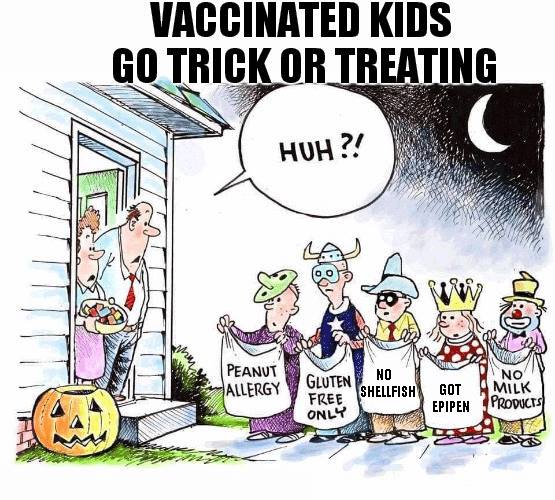Most of this website was created in 2009. I was one of the lonely voices about vaccines causing food allergies. Not so lonely now:
Peanut Oil Used in Vaccines Since the 1960's
"A large subset of patients with Inflammatory Bowel Disease have positive antibodies to Saccharomyces cerevisae, a known marker for diagnosing Crohn's Disease (http://www.ncbi.nlm.nih.gov/pubmed/11252413, http://www.ncbi.nlm.nih.gov/pubmed/14745572). Saccharomyces cerevisiae is brewer's yeast, and is used in the manufacturing of several vaccines, specifically, the Hepatitis B vaccine, where up to 5% of the vaccine can still contain this yeast. (http://us.gsk.com/products/assets/us_engerixb.pdf). Children receive 3 Hepatitis vaccines, starting at less than 12 hours of life. Brewer’s yeast is used a lot in foods and in the manufacturing of supplements, so an inflammatory immune response to ingested Sacchraromyces can flare up into major symptoms of disease in a subset of patients who have developed a significant immune reaction against the injected Saccharomyces from vaccines."
"The ingestion of food proteins, that are also found as antigens in vaccines, and are injected into the body and automatically perceived by the immune system as foreign proteins, especially in the presence of an adjuvant like aluminum, is going to contribute to inflammatory symptoms that manifest in a myriad of ways, depending on the genetics and the constitution of each person affected. Some of these immune responses may not be IgE reactions. This is basic Immunology 101.
Dr. Palevsky http://www.drpalevsky.com/articles_pages/346_Peanut_Oil_in_Vaccines_Since%20the_1960s.asp
The peanut allergy epidemic may have been precipitated by pediatric injections (added 2/16/2015)
Peanut allergy was first documented in several post-WWII studies of adults and children injected with the new ‘wonder drug’ penicillin. However, a challenge existed in that one dose of penicillin would last just a few hours. To prolong its action, army doctor Cpt. Monroe Romansky mixed the drug with what was available during wartime — peanut oil. It was a simple solution — the body would metabolize the oil and slowly release the drug into the bloodstream. Unfortunately, Romansky’s formula also sensitized a handful of children and adults to peanuts.[1] To reduce this side effect, the peanut oil was refined to remove as much sensitizing protein as possible. However, according to the FDA most “highly refined” peanut oil contains trace intact proteins 0.014 to 16.7 µg protein/ml oil.[2] Regardless, with its relative safety in penicillin, peanut oil was adopted into common use within the pharmaceutical industry.
In 1964, Merck announced that it had patented a revolutionary peanut oil vaccine adjuvant. This news was reported in 1964 and 1966in The New York Times[3] with follow up in medical literature through the early 70s. Merck’s Adjuvant 65-4 provoked such high levels of antibodies – 64 times higher than the same vaccine in an aqueous solution — that any vaccine to which it was added could produce many years worth of immunity. Was this potency safe? A 1973 WHO report co-written by Adjuvant 65-4 inventor Maurice Hilleman found the use of peanut oil was relatively safe if properly injected to avoid “severe adverse reactions”.[4] But the safety of the adjuvant was challenged by others including D. Hobson in the Postgraduate Medical Journal (March, 1973). Hobson documented the power of this adjuvant to sensitize recipients to vaccine proteins. This adjuvant created allergies.
Peanut allergy in children and adults grew slowly until the late 1980’s when its prevalence began to accelerate in children in certain countries such as the US, Canada, the UK, and Australia. This rise is documented by ER records, two cohort studies from the Isle of Wight and eye-witness accounts. In the early 1990s, teachers were taken aback by a sudden surge of food allergic kindergarten children.
The rise in life-threatening food anaphylaxis in children coincided with significant changes to the pediatric vaccination schedules of the affected countries: the novel conjugate vaccine Hib B was soon rolled into an unprecedented 5 vaccines in one needle and delivered to babies without benefit of long term study. The injected adjuvants and toxoids designed to provoke the immune system also increased the risk of provoking allergy. Allergy is an evolved defense against acute toxicity.
There are precedents recent and historical (see The Words Allergy and Anaphylaxis were Invented to Describe Vaccine-Injuries) for the causal link between vaccines and mass allergy.
[1] G. Hildick-Smith, et al., “Penicillin Regiments in Pediatric Practice: Study of Blood Levels,” Pediatrics (Jan. 1950): 97-113.
[2] Threshold Working Group, Approaches to Establish Thresholds for Major Food Allergens and for Gluten in Food. III, IV, V, (FDA , March, 2006) http://www.fda.gov/Food/LabelingNutrition/FoodAllergensLabeling/GuidanceComplianceRegulatoryInformation/ucm106477.htm#table-iv-7
[3] Stacy V. Jones, “Peanut oil used in new vaccine; product patented for Merck said to extend immunity,” The New York Times, Business Financial Section (Sept. 19, 1964) 31.
Anon, “Peanut Oil Additive is Found to Improve Flu Shot’s Potency,” The New York Times (Nov. 11, 1966).
[4] M.R. Hilleman, et al., “Imunological Adjuvants Report of a WHO Scientific Group”, World Health Organization Technical Report Series, No. 5959 (Geneva, WHO, 1976) 11.
http://www.smartvax.com/index.php?option=com_content&view=article&id=60
